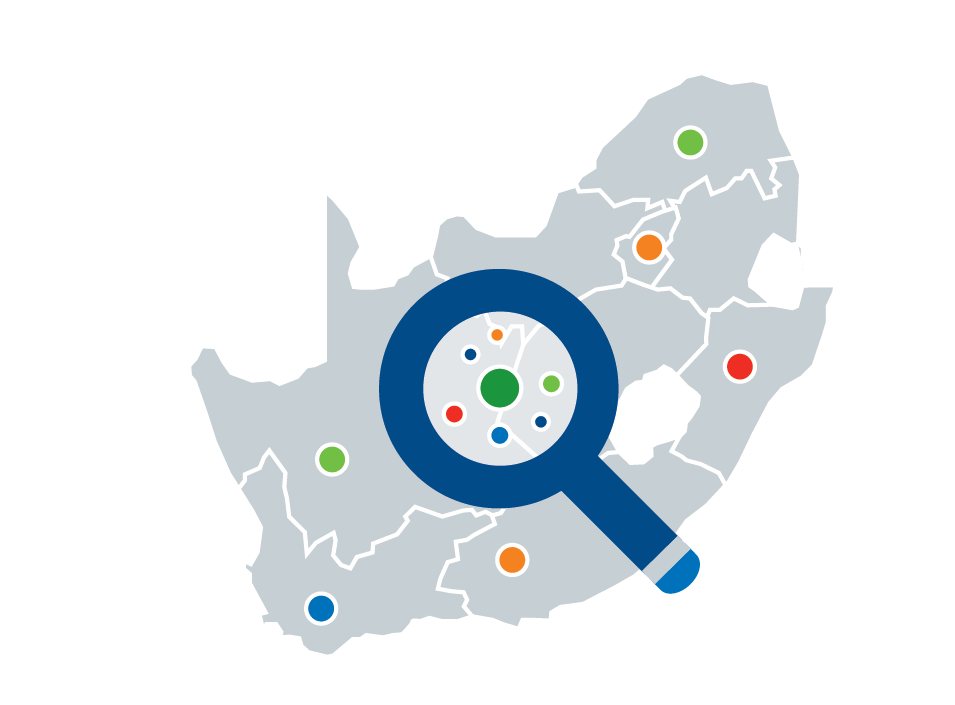What is the purpose of the portal?
The portal is a collection of all publicly available sources of data on risk and vulnerability for South Africa. SARVA does not pre-select sources of data as a single source of truth but provides the fullest range possible of publicly available data. The SARVA portal is updated quarterly as new data becomes available.
Why is SARVA III more than climate change now?
Climate change is only one of the symptoms of the syndrome that is global change. The impacts of climate change cannot be fully understood without acknowledging the interactions and feedback loops between both the drivers and outcomes of global change as a whole. Especially when considering the human dimension, the impacts of climate change may manifest themselves in less than obvious ways. For example conflict over water may be a direct consequence of changing climate, but catchment land-use may be a major driver of reduced water supply and human migration may increase the demand side for water.
Why do we include SDG Indicators that are not directly linked to environmental risk and vulnerabilities?
Why do we include epidemics and pandemics in global change risks?
Recent decades have been marked by the emergence of diseases that move from animals to humans. These are known as zoonotic diseases and examples include Ebola, SARS, MERS, West Nile and Rift Valley fevers. Since there is low resistance to these novel diseases, they have had high impacts on infected human populations, and, in the recent emergence of COVID-19, have reached pandemic status. The United Nations ascribes the emergence of these diseases to the destruction of nature, causing the animal carriers of the disease to come into closer and more frequent contact with people as a consequence of loss of their natural habitat. Exploitation of wildlife and destruction of environments, both global change drivers, are driving the emergence of these diseases among people.
What types of data are held on the portal?
The data on this website falls within three main categories:
- Traditional Spatial Data: refers to data stored as coordinates and features that can be mapped. Examples include topographic, hydrographic, atmospheric science data, soil and forest survey inventories, property and boundary records, and socio-economic data such as population characteristics, labour force survey, etc.
- Multidimensional Data: refers to data with a minimum of three dimensions in either space, time or both. Examples include climate, atmospheric and oceanographic datasets.
- Ecosystem Observation and Biodiversity Data: refers to species and ecosystem-specific data such as presence/absence, protected area boundaries for both the terrestrial and marine systems. The data originates from a variety of sources including scientific field observation, from museum and herbarium collections, or from citizen science contributions, automated data gathering via remote sensing, or autonomous vehicles.
What format is the data in?
- Spatial data formats fall into one of two broad data types, which are raster and vector data.
- Multidimensional data sets, including array databases, NetCDF, and HDF-4 or HDF-5 data.
- Observational and Biodiversity Data can come in a range of formats but for the purpose of SARVA the majority of this data is downloadable in the form of a vector or raster file.
Is the data open-access?
SAEON manages a wide variety of data types and volumes on behalf of its internal and external stakeholders, and is committed to provide access to the data applying open licenses and standardised, interoperable data services. All datasets available in SARVA have a license, which can be accessed through the metadata record. SAEON makes use of Open Licenses such as Creative Commons. The default license allows sharing, as long as subsequent users can share-alike. Some datasets do however limit the re-use of data and may not allow for the use of the data for commercial purposes, for example.
How do I find more information about a dataset?
All datasets made available in SARVA are accompanied by standard-compliant metadata to ensure reusability of all data. All metadata records are made publicly accessible by default. All metadata records contain sufficient information for citation and include the data producer’s contact details or address. Other metadata elements include: an abstract, license, supplementary material, versioning, format, size information, language, resource type, and links to additional information, derived works, and sources used to create the dataset. SAEON has developed configurable, automated methods for assessment of content – including common content mistakes in the metadata record. An example of a metadata record can be found here.
How reliable is the data?
SAEON only accepts publication-ready data and the onus is on the data producer to ensure the quality of the data that they provide. Other than assuring that the data is in a preferred format and that it matches what is described in the metadata, SAEON performs quality assurance on the content of global change datasets made available in SARVA. There is currently no widely accepted methodology for (i) assessing the quality of global change data, or (ii) confirming that data is fit-for-purpose.
In SARVA the measure of data quality will be based on a checklist of 5 indicators derived from South African Statistical Quality Assessment Framework (SASQAF). Data quality is defined as the degree to which a dataset fulfills the characteristics including relevance, accuracy, accessibility, methodological soundness, and integrity.
I can’t find the data I am looking for?
The data available in SARVA is dependent on open access data collections and collaboration with data creators and custodians. SARVA is a ‘Living Atlas’ which means that we are continuously working to add more data, dashboards and maps to the portal.
How do I know when new data is added to SARVA?
Subscribe to updates and news on SARVA and be the first to know when new datasets, tools, or products are developed and released.
What if something is wrong with the Portal?
A ticket logging system has been integrated where a user can request technical support, report a problem, or suggest a new feature or improvements.
